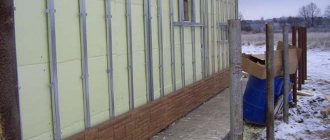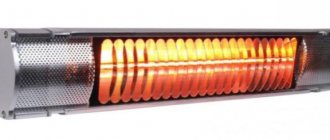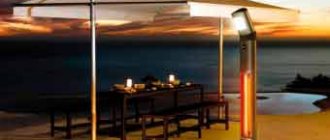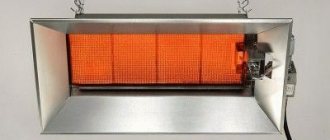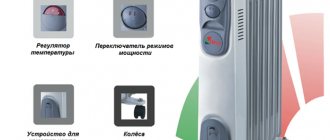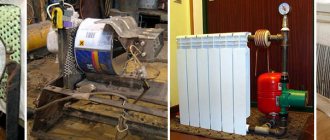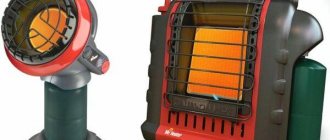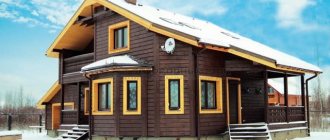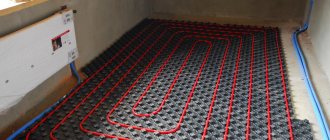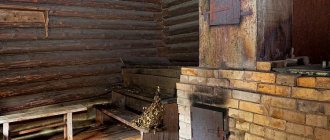Gas heating and its features
If you want to heat your house economically and have gas supplied to your property, choose a gas heating system. It is suitable for those who plan to live in a country house in cold weather or often travel to the countryside. The possibility of installation depends on whether there is a gas pipeline nearby and whether your dacha is a permanent building.
The basis of such a heating system is:
- a gas boiler;
- water flowing through pipes.
The system is connected to the gas pipeline and it begins its work. Heat enters the house constantly. Compared to electricity costs, it can be called cheap, but the system must be constantly monitored. If you will be away for a long time, you should drain all batteries before leaving home. When the boiler is not working, the water in the pipes freezes and they may burst.
Attention! To insert and install a boiler, you must obtain permission from the gas service. Installation is carried out only by professionals.
There is another way to heat a dacha in winter without electricity. You can buy compressed gas cylinders. This is cheap and convenient if communications are located far from your dacha and you cannot connect it to them. Gas cylinders are connected to the boiler. For this, a gearbox is used. Such heating is economical and does not pollute the environment. The main thing is to monitor the condition of the system, observing safety precautions. If necessary, this equipment can be easily adapted for connection to the central gas supply.
Water heating
If you are interested in how to heat your dacha in winter with greater comfort, then we can recommend using heating boilers. Yes, their installation and installation of related equipment will take more time and effort, as well as money. But you can be sure that all rooms will be warm and cozy, and you will have to put a minimum of effort and time into this.
Water heating system for a country house
Depending on the fuel used, heating boilers are usually divided into several types:
- diesel,
- gas,
- solid fuel.
Diesel boilers remain one of the most common in our country. But, basically, this is a legacy of bygone decades. Today, diesel fuel is very expensive, so only very wealthy people can afford to heat their homes in this way. Otherwise, such boilers do not have serious drawbacks. The only one is the unpleasant, acrid, oily smoke. You have to extend the chimney above the roof level, otherwise soot appears on the walls, which is quite difficult to get rid of, and the constant smell of burning will probably not please any of the inhabitants of the dacha.
An even better solution would be to install the boiler in a small extension 5-15 meters from the house, if the size of the plot allows it.
The advantages of diesel boilers are quite numerous. Diesel fuel can be stored in a large tank (several tons) buried on the property, close to the house, in order to be self-sufficient. High energy intensity allows you to burn relatively little fuel to maintain the desired temperature level in the house. The fuel is supplied by itself, thanks to which the temperature in the premises remains practically unchanged all day, and a person does not need to take part in this process.
Gas boilers are becoming increasingly popular these days. Today, most of the country is gasified, and even in small villages people have access to gas. Its cost is significantly lower than the cost of diesel fuel, and their energy intensity is quite comparable.
Gas boiler operation diagram
Otherwise, gas is even better than diesel fuel. It does not smoke when burned, which many users like. It is not necessary to have large reserves of gas if there is a connection to a gas pipeline.
The only disadvantage of this type of fuel is the risk of explosion. A tiny leak, which can occur due to improper installation or accidental breakdown, is enough for the owners to get a real bomb at their side. This scares off many potential owners. Although in most cases this danger is reduced to almost zero. To do this, experts recommend installing gas heating boilers not in basements, but in separate buildings. It is very important to ensure good ventilation in this room. Then the possibility of gas accumulation to a dangerous concentration is completely eliminated.
Electric boiler
Unlike a gas system, an electric boiler is compact and easy to operate. There are different models of electric boilers. The power of the unit is selected depending on the area of the room. Electricity heats the air, then a pump pumps it throughout the heating system. Heated air constantly circulates in a confined space, heating the house.
If you place the boiler in the basement, it does not take up space in the house, but this is fraught with large heat losses. A lot of heat will be spent heating the basement. When planning a house, it is better to allocate a separate room for the boiler, adjacent to the residential sector. Thus, you will ensure high heat transfer with minimal heat loss and save electricity.
Electric boilers operate silently, do not emit any odor, and are easy to install and operate. The specifics of their connection should be taken into account. For example, if your boiler is low-power (3.5-7 kW), it needs to be allocated a separate branch from the distribution panel and installed automatic protection. A powerful unit (from 7 kW and more) is connected only to a three-phase network.
The only disadvantage of an electric heating system is its high price, but people often use it because of its convenience and ease of installation.
Alternative to electrical appliances
There are heaters that use different power sources. Most models still need to be connected to the network, but they will consume much less electricity. Many units are equipped with sensors that monitor the heating process. Devices are:
- oil;
- infrared;
- gas.
Oil heater
Equipment similar to radiators, with heating elements and oil inside. Advantages:
- keeps warm for a long time;
- is cheap;
- operates silently and does not emit odors;
- does not dry out the air around.
The main disadvantage is the long warm-up time. There are more expensive models equipped with fans that speed up the process. Other cons:
- high energy consumption during heating;
- heavy weight;
- the body becomes very hot.
Infrared heater
Heat from the device is transferred to surrounding objects and people, and then into the air. They cost more than oil ones. They work from the network, there are more expensive gas models. Heating acts within a small radius.
The main disadvantage is that they affect the well-being of household members. Pros:
- the heat comes right away;
- do not create odors or noise during operation, and do not dry out the air;
- easy to use and install;
- if it falls, the protection function turns off the device;
- Most models are equipped with sensors that prevent overheating.
Gas devices
Home heaters run on liquefied gas, which is sold in cylinders. There are infrared and catalytic.
The latter give off more heat and save fuel. The room heats up very quickly. They are expensive, repairs will also cost a decent amount. Main disadvantages:
- risk of gas leakage;
- if it is very cold, the heater may not turn on well;
- convectors require a chimney;
- short service life.
The main advantage of gas equipment is low cost and low fuel consumption.
Liquid fuel boilers for heating
A steel or cast iron boiler is connected to a water heating system. The following is used as fuel for such boilers:
- diesel;
- kerosene;
- processed oils;
- fuel oil.
To install the system, you also need a separate room, since we are talking about bulky and massive equipment.
There are single-circuit and double-circuit boilers. A unit with one circuit heats only the coolant. The dual-circuit model can heat both coolant and hot water. Any water heater (storage or flow-through) can be connected to it. Place the equipment on the wall or floor. Boilers that are placed on the floor are massive and heavy and make a lot of noise when operating. When installing them, additional equipment is used, which requires a lot of space. When operating liquid fuel units, soot and foreign odors always appear, so you must immediately take care of installing ventilation.
If you have a small house, you can install a wall-mounted boiler, which does not cause any hassle during operation.
Portable mini ovens
A good alternative to a conventional stove is mobile structures that are heated with wood.
Potbelly stoves
Steel or cast iron devices with a firebox, ash pit and chimney. Some ovens are equipped with a flat surface. Main advantages:
- easy to carry, takes up little space;
- quickly heat the house;
- heated with firewood, wood chips, etc.;
- are inexpensive.
Flaws:
- Doesn't last long;
- the body becomes very hot;
- the room will have to be ventilated;
- the chimney often gets clogged.
For safety, structures are installed away from walls and flammable objects on a heat-insulating base.
Buleryan
It works on the principle of a convector. The wood in the Buleryan stove does not burn, but slowly smolders. The room warms up well and quickly. The furnace body does not heat up.
Flaws:
- frequent cleanings;
- In order not to fill the room with smoke, the chimney is made high - 3-5 meters.
The stove gives off heat for 12 hours from one load of firewood. To maintain the temperature, you need to learn how to properly adjust the damper. The fuel must be well dried.
Solid fuel systems and their applications
Due to the high cost of electricity, people install solid fuel heating systems. They are similar to metal stoves, but their design is different. They use the following as fuel:
- wood waste;
- peat bog;
- briquettes with coal.
The solid fuel boiler is also connected to the pipes of the general heating system. It is reliable, easy to operate and “omnivorous”, because you can put all types of solid fuel in it. Combustible products need to be purchased with a reserve so that they do not run out suddenly. The efficiency of the unit is low, and its chamber must be cleaned regularly at the end of the combustion cycle. This inconvenience is compensated by the ease of use and “unpretentiousness” of the universal unit and its components.
The solid fuel boiler does not depend on other communications and operates for a long time after a single load. This ensures economical consumption of coal or coke. If you load it with firewood or wood waste, it works continuously for 48 hours, without the need to add fuel again.
On a note! When using coal briquettes or coal, the boiler supplies the house with heat for 5 days without interruption.
Types of heating systems
Types of heating systems are characterized by size, ability to heat a space in minutes and for a long time, accessibility of installation, and safety. Each type of energy uses an adapted heating system. The presence of such a system at the dacha helps to live comfortably during the cold period.
| Energy | Heating equipment |
| Earth temperature | Heat pump. |
| Air | Electric or gas convector with fan, Buleryan. |
| Water | Hydraulic accumulators, gas, wood or electric boiler with radiator system. |
| Fire | Gas boiler, convector, stove, potbelly stove, buleryan, gas cylinder. |
| Wind | Wind generator |
| Sun | Solar collectors, solar batteries. |
| Electricity | Film radiant electric heaters, warm floors, warm Finnish ceilings, baseboard heating. |
It is possible to heat a dacha in winter, both “with your own hands” and through system installations.
On a note!
The rate of heating a room depends on the size of the room area and the heating device.
Heating a cottage with gas
The ability to heat a dacha in winter without electricity is provided by gas heating. Gas is a cheap fuel and its use heats the room autonomously.
Gas is used in two physical states:
- Gaseous. Natural gas is taken in its pure form from the depths of the earth and delivered to gas storage facilities. From them, through pipes, it enters the boilers of residential buildings. With the help of a combustion wick, for which gas acts as fuel, the coolant (water or air) is heated, warming the room. The downside is that only 66% of the area where the summer cottages are located are equipped with a gas system.
- Liquid state. Synthetic gas, propane, is exported in liquefied form in solid metal cylinders. Through the reducer, the gas is transferred to the combustion burner, which warms the air or water. This method allows you to live independently of a common central heating system. It makes it possible to heat a dacha even in a remote area of the earth, where a car with a cylinder can reach.
Compared to electricity, gas is several times cheaper. This helps reduce utility costs for maintaining the premises. When calculating the annual figure, gas heating saves the budget by 2 times.
Attention! The gas boiler requires servicing once a year.
Electric heating of the cottage
Electricity is a popular heating method among the population. Heats a country house using coolant and independently. When using coolant, electric boilers are used that heat up the internal heater. The heater releases heat to the water, which warms the room. To ensure sufficient coverage of the heated area, radiators are used. Radiators in combination with polypropylene pipes transfer heat to the room in 1/2 hour. The house remains warm for 5 hours. Electricity is supplied from the power grid and from solar analog batteries.
Electricity also acts as a source of thermal energy in its own right. Insulation of the floor and baseboard with electric cables provides sufficient heating for a small space. It is worth considering that in winter this will take more time. This type of heating acts as a source of additional heat supply.
Finnish warm ceiling technologies have been recommended by positive reviews. Electrical cables are installed between the insulation and the decorative elements of the ceiling. Thermal energy operates on the principle of infrared radiation, which is reflected from above onto surrounding objects that act as coolants.
An analogue version operating on the radiation principle is film radiant electric heaters. They are resistors located between the polymer coating. Under electricity, the resistors become hot, transferring heat to the aluminum coating. The coating, due to its area, reflects heat from the outer surface of the room.
Using electricity is a way to heat a summer house built in a place where there is no gas.
Universal boilers
They are used if you need to heat your dacha in winter without gas. A universal boiler becomes a “savior” when there are constant power outages on the site. Sometimes it is not possible to regularly buy coal for solid fuel units, and a universal system is the only way out. It can operate on the following types of fuel:
- liquefied gas;
- liquid substances;
- coal;
- firewood
The system works by heating the coolant. The boiler is equipped with several burners designed for different types of fuel. It is controlled automatically and is equipped with overheating protection, and its operation is safe for the user. To use different types of fuel, the system provides for changing settings. It regulates the operating mode of the boiler, and it always produces optimal efficiency.
Brick ovens
The main “heating unit” of a brick stove is the wood-burning firebox. Oxygen is constantly supplied to it so that the flame is at the desired level. The stove is equipped with a chimney that removes waste combustion products to the outside. If you follow these rules and regularly clean the chimney, the stove will always provide warmth to the residents of the house.
The ash pan (or blower door) provides air flow. The masonry laid inside the furnace ensures that combustion products escape outside. There are different stove designs. To heat the cottage, use one of four:
- “Dutch”;
- fireplace;
- “Swedish”;
- Russian.
The brick oven is compact. You can give it any design with your own hands, in accordance with the interior of your house or cottage. It is fireproof, and natural materials (stone, brick) are used in its production. However, building a stove requires serious skills, without which it will not be possible to create a full-fledged heating system. Making masonry is a long and labor-intensive process that requires time and skill. The cost of natural materials is high, but if you are the owner of a real stove, it will serve you for a long time. In addition, the stove does not depend on gas and electrical communications. If you have firewood and know how to heat it, it will warm a person in any cold weather.
Convectors
The devices heat rooms by circulating air. There are gas and electric. Disadvantages of gas models:
- need a chimney;
- dry the air;
- After switching off, the room cools down quickly.
Pros:
- heats up quickly;
- the body does not heat up;
- heating sensors help save electricity;
- they don't buzz.
Metal stoves
The efficiency of a metal furnace depends on the density of the fuel. There should be no free space between solid elements. Firewood inside a metal stove must be placed in a cage. The denser the filling, the longer it will burn, providing heat to the entire room. When properly stacked with firewood, a metal stove retains heat for 24 hours.
As wood smolders, it releases heat energy, and the stove has a special compartment for air supply. The characteristics of the metal affect heat transfer and thermal conductivity. Despite the weak accumulation of heat, the thermal conductivity of the metal is high. This stove produces heat efficiently, is compact, and can be installed anywhere. Cast iron stoves are reliable and last longer than products made from other materials.
Advice! You can buy a stove of an unusual shape to decorate your country house setting.
Metal stoves are not installed in large houses, because they will not provide a comfortable temperature in a building with a large area. Their safety level is lower than that of stone or brick products, but they are quite suitable for a small dacha. You need to follow safety precautions and stack firewood correctly.
Alternative Heating Methods
Sometimes at the dacha it is impossible to do without electric heaters. They are:
- infrared;
- fireplace type;
- convector;
- oil;
- ventilation.
Infrared heaters emit soft radiation that effectively warms the room. They are installed on the top of the wall or on the ceiling. Warming up occurs quickly, and there are no difficulties with adjustment. The infrared heater is easy to install and does not take up much space in the room.
Electric fireplaces are beautiful. Sometimes they are difficult to distinguish from real fireplaces or stoves. They have good heat dissipation, and if the electric fireplace has high power, the room will heat up quickly. The disadvantage of electric “ovens” is that they consume a lot of energy, especially when used regularly.
Convector heaters are highly efficient, lightweight, and can be easily installed independently. They gently heat the room and are not as energy-intensive as fireplaces. Oil units take a long time to warm up, but consume little electricity. If you urgently need to warm up the room, their use is inappropriate.
Heat fans quickly heat a room, but they make a lot of noise and absorb moisture from the air. Dry air is harmful when a fan is used for a long time and can harm people with respiratory diseases. Fans need to be monitored by turning them off periodically. For constant heating, it is better not to use heat fans.
How to quickly and effectively warm up when arriving at a cold dacha
We will talk about how to heat a summer cottage in the cold.
That is, a house not suitable for winter living. This is exactly what I have, and I will share with you how I keep warm in it when I come to the dacha in winter. How to quickly and effectively warm a country house in winter
We didn’t build a good large stove or boiler with radiators in our time (if you’re interested, here’s more about my house), and two small stoves - in the kitchen and in one of the bedrooms - although effective for these rooms, they just require too much hassle: apply and chop firewood, then constantly make sure to add fresh firewood in time to the burnt-out ones. This is very annoying, especially when you need to do something in the garden and don’t want to be distracted. Yes, and you can simply miss the moment due to worries, and the stove will go out. In such a situation, electricity naturally comes to the rescue.
Dacha in winter
What have I tried to heat my house during the cold season! It all started with ordinary oil heaters . But over time, it turned out that they are not nearly as effective as other, new heating systems.
The thing is that an oil heater heats the air almost only near itself. Of course, convection occurs, warm air moves upward and slightly to the sides, but such a radiator warms up the room as a whole for quite a long time. It can be considered useful if it is somewhere close to you when you work at your desk. But for heating, especially the faster heating that we are talking about now, these heating devices are hardly suitable.
Oil heater
In search of a solution to the problem of heating rooms in the country, I tried many different options. The solution with electric floor heating turned out to be very useful. a warm floor on the first floor: a heating cable was laid under the tiles. The feeling is pleasant and unusual: with a low air temperature in the room as a whole, you feel very comfortable. Your feet are warm and your head is cool. The tiled floor with the laying mortar gradually warms up and holds the temperature for a long time, gradually releasing heat into the room.
We made our “warm floor” a long time ago, back in the “last century,” almost experimentally, and my husband did not believe in its effectiveness. So we then “forked out” for only half the amount of cable needed according to calculations for our premises. And the underfloor heating system is quite inert; it does not heat the floor instantly. Therefore, with the arrival of frost, it is necessary to use additional sources of heating the rooms.
a fan heater or “heat gun” warms up the air in the room best and fastest Due to the forced air supply, active circulation of a warm flow occurs throughout the entire volume of the room. The room warms up very quickly, but cools down just as quickly after the device is turned off.
My fan heater
It also has a couple of disadvantages: it is quite noisy and consumes too much electricity - 2 kW. So I settled on a small infrared heater.
It consumes 1.2 kW at maximum mode. But for my small rooms, it is enough to turn it on in half mode if the temperature outside the walls of the house is about zero degrees or slightly lower. That is, a room of 16 m² is heated at 0.5 kW. This is enough to keep the temperature in the bedroom on the second floor with half-brick walls, insulated with mineral wool and lined with clapboard, around +18...+20°C, when the thermometer outside the window shows 0...+5°C.
UFO
This photo is not mine, but I have exactly the same one made domestically. And recently I purchased another one, similar, but Turkish, small, with a maximum power of 1.5 kW. It has 3 heating elements and therefore allows you to set the mode to 0.5 kW, 1 kW or 1.5 kW, depending on the heat demand.
Infrared heater with 3 heating modes
I place the infrared heater on the floor or a little higher - on a chair or stool - in the far corner of the room. Installing it close is ineffective, because then it strongly heats a small area in front of it, while other surfaces fall into the shade and do not heat up. And it's unpleasant.
An infrared heater works on the same principle as our luminary - the Sun. Have you noticed how warm it is in the sun in spring? But as soon as you step into the shade, you immediately freeze. This happens because infrared radiation heats surfaces rather than air, and they then give off heat. This is how soil heated by the sun gives off heat, and in the same way, heated walls, furniture surfaces and floors give off heat in a room. Infrared heaters must be handled with care : they get very hot on the front side, and any object that comes into contact with it can ignite. The distance to flammable objects must be at least 40 cm. And under no circumstances should this device be covered with anything!
I also have a couple of large UFO heaters - models with one large heating element. But I like them less: the lamp heats up too much, and there is no smooth adjustment of the incandescent power. The thermostats installed on them simply periodically turn on the lamp at full power and then turn it off. For heating a room, this may not be important, but when you are present in it, the sensation is very unpleasant: the irritating difference is from too much heat when the lamp is turned on to sharp cold when it is turned off. Therefore, I chose a small heater with two heating modes.
UFO heater. Photo from the site autocentre.ua If you, like me, go to the dacha in winter and sometimes stay there overnight, it’s worth purchasing electric mattresses or electric sheets . They allow you to warm up your bed well before going to bed. I turn on such a mattress, placed under a regular, not too thick mattress, some time before bed. He manages not only to warm up, but also to dry the bed, which inevitably becomes damp if the house has been empty and cold for a long time.
Electric mattress
I don’t dare sleep with the electric mattress on. Once upon a time, some acquaintances almost suffered a misfortune: due to a malfunction of the heating pad, a blanket began to smolder, and the owner almost got burned. So I just warm up the bed thoroughly and then turn off the mattress. This is enough to sleep warm all night. Well, if it suddenly gets cold, you just need to turn it on for a while to warm up a little, and then turn it off again. Such a mattress or sheet consumes very little - 40-60 W.
This is how things stand with heating in my dacha now. But in my dreams and plans I have an infrared space heating . There are many options: from heating panels to infrared film floors, simply laid under the carpet.
Infrared panel. Photo from freemarket.kiev.ua
I first learned about these systems somewhere in 2000-2002. I was at an international exhibition on heating and water supply and, walking past one of the pavilions, I suddenly felt a gentle warmth. I couldn't understand where it was coming from. There were no heating devices in sight. Just a very beautiful reproduction of Van Gogh’s painting with his famous cypress trees. And nearby at the table two handsome, narrow-eyed Korean boys were bustling around, handing out pieces of some unusual film to visitors. It turned out that it was the same infrared film, which consisted of flat carbon rods connected to each other on both sides by a special flat copper bus and sealed between layers of transparent plastic. And it was precisely this film that was hidden under the wonderful warm picture on the wall. What I subsequently learned about this heating system impressed me very much.
Infrared film systems operate on a special principle. They do not just warm up, for example, the floor covering (tile, linoleum, carpet), like most other floor heating systems. About 90% of infrared radiation is in the far range. These heat rays overcome the floor covering, travel further and heat objects within their field of action. Including the human body. Unlike other room heating systems, the infrared system is not afraid of drafts - after all, it is not the air that warms us, but the rays. It does not dry out the air and even ionizes it additionally.
Judging by the numerous publications of research results conducted by various reputable institutes, the infrared heating system is also very useful . She, like the sun's rays, not only warms, but also heals the human body. Without the Sun and its long-wave radiation, there would be no life on Earth. These rays are even called biogenetic. It is well known that the absence of sunlight for a long time has a negative impact on our health: immunity falls, we are overcome by illnesses, and our health deteriorates. Our body needs constant replenishment of long-wave heat.
A sick heart, kidneys, impaired blood circulation, colds, sore joints, excess weight, cellulite, skin burns, reduced immunity, digestive problems, nerves, injuries, skin diseases - all this, as researchers write, can be successfully treated with infrared radiation . And some US scientific laboratories (O&P Medical Clinic, Infrared Therapy Researches) even report the effectiveness of far-infrared radiation in destroying certain types of hepatitis virus, reversing liver cirrhosis, inhibiting the growth of cancer cells, treating psoriasis, increasing the production of insulin in diabetics and neutralizing the effects of radiation irradiation.
Of course, you need to choose a heating device according to your conditions and preferences. You can get acquainted with various models and choose the one that suits you in our market, section Heaters.
Heater Laguna RUB 1,299
Russian Vegetable Garden
Heater Palma RUB 1,299
Russian Vegetable Garden
Heater Mountains RUB 1,299
Russian Vegetable Garden
Heater Waterfall RUB 1,299
Russian Vegetable Garden
I purchased a small mat made of infrared film to heat the floor in the kitchen.
Before this, to keep my feet warmer, I simply laid a sheet of foam foam between the homespun carpet and the cold tiles. I laid a film heater on it, and a path on top. The kitchen has become much more comfortable. Now the cat loves to sleep there. And these little animals, as you know, will not go to sleep anywhere. Infrared films are laid not only on the floor, but also to make warm walls and ceilings, which are mounted behind the inner lining. It might look something like this:
This is how infrared heating works. Photo from ultra-term.ru
In addition to infrared heating, I am also considering installing “warm baseboards” . These are narrow and long electric heaters of various systems (water and electric), which are installed at the bottom of the walls, preferably along the entire perimeter. By the way, skirting systems also come in the form of an infrared narrow film.
The peculiarity that determines the effectiveness of using a baseboard heating system for a house is that such a heater installed along the perimeter of the room at the very bottom of the wall creates a heat shield that extends from the bottom to the top of the entire wall. This prevents the air inside the room from cooling from contact with cold walls. The cold from the walls and windows does not penetrate into the room. The walls also warm up and are freed from moisture. And dry walls remove less heat outside, and they themselves begin to radiate heat into the room.
This type of plinth is a godsend for a newly built house that still has damp walls. It will really help to make corner and end rooms warm. It very effectively prevents condensation, especially on large windows, such as on a balcony, in a greenhouse, conservatory, or basement wall.
Our family already has experience using baseboard heaters. My son has a large stained glass window from floor to ceiling in his apartment, which was a constant source of cold. The oil heater helped modestly - the window was very wide, and it only heated the air in one place. After installing two of these baseboard heaters (1 m long and 180 W each), which are very easily attached directly to the window frame, the situation has changed radically.
Warm baseboard under the window
Now not only does warm air rise up along the window, but cold air does not spread along the floor as before. The floor on which children constantly play has become much warmer.
Yes, and don’t forget, before you warm the room, open the windows and let in a draft for about five minutes . Fresh air will warm up much faster. I read this advice in a book about fireplaces. It turns out that after ventilation (and in any frost!) the room warms up 7 times faster.
In the next video, our regular author Olga Voronova talks about how you can insulate a country house in half an hour. By following simple recommendations, you can significantly reduce heat loss, so heating your home will be much easier.
You can read about other important nuances in the article How to quickly warm up a country house: 3 important conditions and about stove matters: choosing firewood, cleaning chimneys... Well, while the home is warming up, country little things will help us, which will warm us in the cold.
Modern heating system or stove
When building new houses, designers provide efficient heating systems in advance. There are developments that allow:
- quickly warm up a room of any size;
- quickly warm up a house with a low level of thermal insulation;
- automatically drain water from the heating pipes.
The system maintains a constant water temperature. For laying pipelines, pipes made of metal, polypropylene or metal-plastic are used. These materials serve for decades without losing their original properties. If you handle the boiler correctly, the installation will quickly pay for itself, but not everyone can afford to buy it.
For this reason, summer residents living in their “patrimony” in cold weather more often install stoves or use heaters. Any system with a boiler requires regular maintenance and specific handling. The stove also needs to be cleaned, especially if we are talking about a classic Russian stove (with a chimney and brickwork). Sometimes people get used to simple heating methods and are quite content with homemade devices.
How does infrared film work?
Infrared film is one of the alternative methods of heating a room. It accumulates heat rays and releases them out. The specifics of its action can be compared to how the sun heats the asphalt in summer. If you have an electric heating system installed at your dacha, use infrared film. It will help save more than 20% of heat, and you will not need electric heaters.
IR film has the following characteristics:
- operates on a 220 volt network;
- peak power consumption – 210 W/m²;
- daily electricity consumption – from 20 to 60 W/m²;
- maximum heating temperature – 55©;
- width – from 0.5 to 1 m.
The film is heated within 5-7 minutes. It can be quickly installed anywhere without worrying about the height of the ceilings. During operation, avoid contact of the film with sharp and cutting objects.
Reviews
I warm up a room at the dacha of 15 square meters with two oil heaters. Suitable for temporary short-term residence. But my plans include stove heating, since I plan to spend more time at the dacha in the winter.
After the rise in gas prices, I installed an electrode boiler, which operates on the “Winter-Summer” principle. I'm happy with the boiler; its area of 25 square meters heats up perfectly. But before installing the equipment, I insulated the dacha for better heat retention.
At first I decided to install a boiler, but I realized that the system would still be expensive and then I would have to live in the country to pay for it. Therefore, I decided to heat the dacha with a homemade potbelly stove. I am at the dacha several days during the winter, so this type of heating suits me quite well.
Proper thermal insulation in the house
When building a private house, you need to immediately insulate the roof. It has a frame structure. It is covered with other materials, so insulation must be laid during the assembly process. There are types of insulation that are laid on top of the ceiling: these are large slabs of extruded polystyrene or foam. The same material is used for wall insulation. In addition to polystyrene, you can use other types of “thermal insulators”:
- mineral wool;
- polyurethane foam and basalt blocks;
- polyurethane foam.
These materials are used to insulate ceilings, walls and floors. They retain warm air without allowing cold and moisture to pass through, which reduces the cost of artificial heating. Large cracks can be sealed with polyurethane foam, and slabs can be laid on top.
Information! High-quality thermal insulation materials are produced by the Russian company Izoplat.
Some useful tips
If your home maintains a constant temperature of about 5©, this is enough to “start warming up”. Stable temperatures will be ensured by high-quality insulation of doors, windows, roofs, floors and ceilings. They cannot be neglected: this will lead to large heat losses. Heating systems will not be able to warm up a room that does not have reliable insulation.
Use electric heaters with temperature sensors. There are safe devices that can be left unattended for a short time. In winter, save heat and do not heat unused rooms. For wintering at the dacha, a heated kitchen and one room are enough. Place other parts of the house in case of emergency.
When installing a boiler or furnace, learn how to properly add and use fuel. This will help you retain heat and maximize the efficiency of your heating system.
There are many ways to heat private homes. Each of them has its own specifics. Before installing a boiler or furnace, you must take into account all the details of their operation. You can make a simple stove yourself, but to install a complex installation it is better to invite a specialist.
Gas heating
Gas heating of a dacha is a complex engineering system. Before installing expensive equipment, you need to ensure good thermal insulation. An ideal system should operate silently, economically, warmly, and unnoticeably. Gas equipment requires constant maintenance and preparation for the winter season. Maintenance must be carried out by certified specialists.
A water system is best suited for gas heating. If the system will not be filled in winter, the pipes must be filled with antifreeze. This nuance will protect the system from defrosting. Installation of gas equipment includes the installation of radiators that will give off their heat to the room. Installation of a heating system has its own characteristics, which a specialist must warn about.
